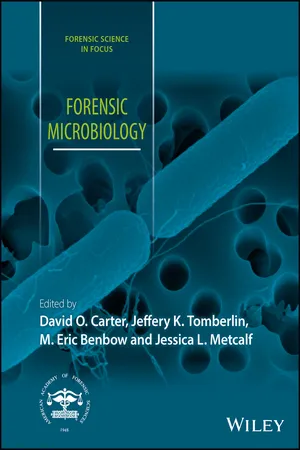CHAPTER 1
A primer on microbiology
David O. Carter1, Emily N. Junkins1,2 and Whitney A. Kodama1
1 Laboratory of Forensic Taphonomy, Forensic Sciences Unit, Division of Natural Sciences and Mathematics, Chaminade University of Honolulu, Honolulu, HI, USA
2 Department of Microbiology and Plant Biology, University of Oklahoma, Norman, OK, USA
1.1 Introduction
In many ways microorganisms are an ideal form of physical evidence. They can be found virtually everywhere and are certainly present in every habitat occupied by humans. Thus, microbes could be collected from every scene under a forensic investigation, yet not all microorganisms are everywhere; like many forms of trace evidence, some microbes are found only in certain locations due to having a preferred habitat, much like how insects, birds, and reptiles have a preferred habitat range. Another valuable characteristic of microorganisms is that many of them can transform themselves into a highly durable structure that is designed to survive harsh conditions, which increases the likelihood of their survival and discovery. Considering all of these attributes, it is probably not surprising that microorganisms have been used as physical evidence since the early days of forensic science, particularly to establish the cause of death (e.g., MacCallum and Hastings, 1899). Forensic microbiology has since grown into an exciting discipline relevant to several areas of forensic science including medicolegal death investigation (Caplan and Koontz, 2001; Forbes et al., 2016), bioterrorism (Budowle et al., 2011), and product authenticity (Brzezinski and Craft, 2012). It will be absolutely fascinating to learn of the new discoveries in forensic microbiology over the next few decades.
Historically microbes have been used almost exclusively as spatial evidence—physical evidence that is used to associate people with diseases, objects, and/or locations (Locard, 1930a, b, c; Caplan and Koontz, 2001; Tridico et al., 2014; Wiltshire et al., 2014; Young et al., 2015). This application is similar to the use of any other form of trace evidence, such as soil (Bisbing, 2016), paint (Kirkbride, 2016), glass (Almirall and Trejos, 2016), and fibers (Houck, 2016). However, recent research has shown that microorganisms represent a relatively unique form of physical evidence that can also serve as temporal evidence, evidence that is used to establish a timeline. This application uses the ability of microorganisms to respond rapidly to changes in their environment (e.g., Carter and Tibbett, 2006), and these changes are temporally predictable (Metcalf et al., 2013; Pechal et al., 2014; Guo et al., 2016; Metcalf et al., 2016), with an apparent ability to serve as an estimate of the postmortem interval (Chapter 2) and human habitation (Chapter 13) interval.
We are currently in an exciting time when multiple research groups around the world are leading advances in postmortem microbiology and trace microbiology (Fierer et al., 2010; Benbow et al., 2015; Lax et al., 2015; Metcalf et al., 2016). These advances are occurring rapidly and have great potential to significantly change how microorganisms are used as physical evidence. Microorganisms will likely play a greater role as physical evidence in the future, so the purpose of the current chapter is to provide an introduction to some fundamental aspects of microbiology and microbial ecology to help the reader develop an appreciation for the vast diversity of microorganisms and how they can be used to identify a location or time period of investigative interest. It is not possible for this chapter to review all known microorganisms, so the contents hereinafter will place an emphasis on bacteria that are of interest to the most recent research relevant to the scope of this book, postmortem microbiology and trace microbiology (e.g., Benbow et al., 2015; Iancu et al., 2015; Finley et al., 2016; Metcalf et al., 2016). However, domains Archaea and Eukarya are also highly relevant, and the current chapter will reference relevant work, when possible, that focuses on these very important taxa within a forensic context.
1.2 Microbial characteristics
Microorganisms can differ in many ways including their morphology, method of movement (motility), metabolic strategy, environmental requirements, and several other characteristics (Brown, 2015). The current chapter will address this issue with relative simplicity by describing how microorganisms survive with a brief description of some relevant taxa.
1.2.1 Microbial taxonomy and function
Classification of life has proven to be a challenge. Presently, there are a number of opinions on how we should organize organisms in terms of their relationship to one another. Although not the focus of this chapter, this topic is of great importance as it impacts our ability to assess microbial communities in general. Thus, we suggest individuals with an interest in forensic microbiology remain cognizant of the ever‐shifting landscape of microbial taxonomy.
For this text, we focus our discussion on three major groups of microorganisms organized as domains: Archaea, Bacteria, and Eukarya (Woese et al., 1990) although a new perspective on this classification was presented recently (Hug et al., 2016). The List of Prokaryotic Names with Standing in Nomenclature (http://www.bacterio.net) currently divides Bacteria into 30 phyla (Table 1.1) and Archaea into...
